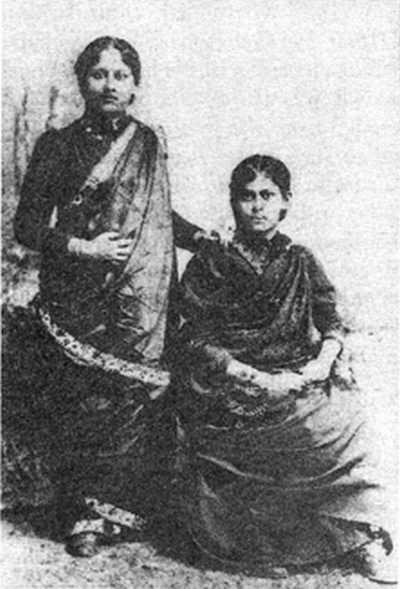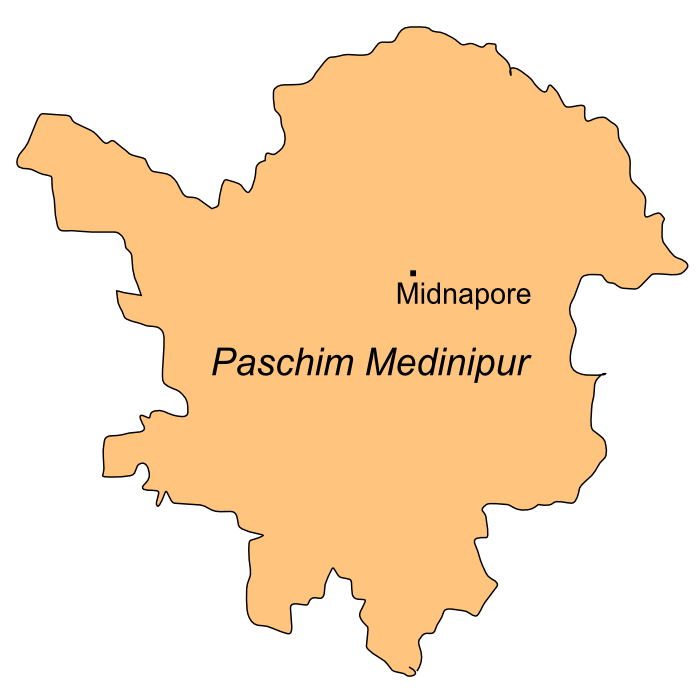|
Sarala Devi Chaudhurani
Sarala Devi Chaudhurani (born Sarala Ghosal; 9 September 1872 – 18 August 1945) was an Indian educationist and political activist, who founded Bharat Stree Mahamandal in Allahabad in 1910. This was the first national-level women's organization in India. One of the primary goals of the organization was to promote female education. The organization opened several offices in Lahore (then part of unpartitioned India), Allahabad, Delhi, Karachi, Amritsar, Hyderabad, Kanpur, Bankura, Hazaribagh, Midnapur, and Kolkata to improve the situation of women all over India. Biography Early life Sarala was born in Jorasanko, Kolkata on 9 September 1872 to a well known Bengali intellectual family. Her father Janakinath Ghosal was one of the first secretaries of the Bengal Congress. Her mother Swarnakumari Devi, a noted author, was the daughter of Debendranath Tagore, an eminent Brahmo leader and father of poet Rabindranath Tagore. Her older sister, Hironmoyee, was an author and founder o ... [...More Info...] [...Related Items...] OR: [Wikipedia] [Google] [Baidu] |
Kolkata
Kolkata (, or , ; also known as Calcutta , the official name until 2001) is the capital of the Indian state of West Bengal, on the eastern bank of the Hooghly River west of the border with Bangladesh. It is the primary business, commercial, and financial hub of Eastern India and the main port of communication for North-East India. According to the 2011 Indian census, Kolkata is the seventh-most populous city in India, with a population of 45 lakh (4.5 million) residents within the city limits, and a population of over 1.41 crore (14.1 million) residents in the Kolkata Metropolitan Area. It is the third-most populous metropolitan area in India. In 2021, the Kolkata metropolitan area crossed 1.5 crore (15 million) registered voters. The Port of Kolkata is India's oldest operating port and its sole major riverine port. Kolkata is regarded as the cultural capital of India. Kolkata is the second largest Bengali-speaking city after Dhaka ... [...More Info...] [...Related Items...] OR: [Wikipedia] [Google] [Baidu] |
Hyderabad, Andhra Pradesh
Hyderabad ( ; , ) is the capital and largest city of the Indian state of Telangana and the ''de jure'' capital of Andhra Pradesh. It occupies on the Deccan Plateau along the banks of the Musi River, in the northern part of Southern India. With an average altitude of , much of Hyderabad is situated on hilly terrain around artificial lakes, including the Hussain Sagar lake, predating the city's founding, in the north of the city centre. According to the 2011 Census of India, Hyderabad is the fourth-most populous city in India with a population of residents within the city limits, and has a population of residents in the metropolitan region, making it the sixth-most populous metropolitan area in India. With an output of 74 billion, Hyderabad has the fifth-largest urban economy in India. Muhammad Quli Qutb Shah established Hyderabad in 1591 to extend the capital beyond the fortified Golconda. In 1687, the city was annexed by the Mughals. In 1724, Asaf Jah I, the ... [...More Info...] [...Related Items...] OR: [Wikipedia] [Google] [Baidu] |
Mysore State
Mysore State, colloquially Old Mysore, was a state within the Dominion of India and the later India, Republic of India from 1947 until 1956. The state was formed by renaming the Kingdom of Mysore, and Bangalore replaced Mysore as the state's capital. When Parliament of India, Parliament passed the States Reorganisation Act, 1956, States Reorganisation Act in 1956, Mysore State was considerably enlarged when it became a linguistically homogeneous Kannada language, Kannada-speaking state within the Republic of India by incorporating territories from Andhra State, Bombay State, Coorg State, Hyderabad State (1948–1956), Hyderabad State, and Madras State, as well as other petty fiefdoms. It was subsequently renamed Karnataka in 1973. History The Kingdom of Mysore was one of the three largest princely states in British Raj, British India. Upon Indian independence movement, India's independence from Britain in 1947, Maharaja Jayachamarajendra Wadiyar signed the instrument of acces ... [...More Info...] [...Related Items...] OR: [Wikipedia] [Google] [Baidu] |
Indian Independence Movement
The Indian independence movement was a series of historic events with the ultimate aim of ending British Raj, British rule in India. It lasted from 1857 to 1947. The first nationalistic revolutionary movement for Indian independence emerged from Bengal. It later took root in the newly formed Indian National Congress with prominent moderate leaders seeking the right to appear for Indian Civil Service (British India), Indian Civil Service examinations in British India, as well as more economic rights for natives. The first half of the 20th century saw a more radical approach towards self-rule by the Lal Bal Pal, Lal Bal Pal triumvirate, Aurobindo Ghosh and V. O. Chidambaram Pillai. The final stages of the independence struggle from the 1920s was characterized by Congress' adoption of Mahatma Gandhi's policy of non-violence and Salt March, civil disobedience. Intellectuals such as Rabindranath Tagore, Subramania Bharati, and Bankim Chandra Chattopadhyay spread patriotic awarenes ... [...More Info...] [...Related Items...] OR: [Wikipedia] [Google] [Baidu] |
Bethune College
Bethune College is a women's college located on Bidhan Sarani in Kolkata, India, and affiliated to the University of Calcutta. It is the oldest women's college in India. It was established as a girls' school in 1849, and as a college in 1879. History The college was founded as the Calcutta Female School in 1849 by John Elliot Drinkwater Bethune, with the financial support of Dakshinaranjan Mukherjee. The school started in Mukherjee's home in Baitakkhana, with 21 girls enrolled. The following year, enrolment rose to 80. In November, on a plot on the west side of Cornwallis Square, the cornerstone for a permanent school building was laid. The name "Hindu Female School" was inscribed on the copper-plate placed in the stone and on the ceremonial silver trowel made for the occasion. Support for the school waned after Bethune's death in August 1851. The government took it over in 1856, renaming it Bethune School after its founder in 1862–63. In 1879 it was developed into Bethun ... [...More Info...] [...Related Items...] OR: [Wikipedia] [Google] [Baidu] |
Bachelor Of Arts
Bachelor of arts (BA or AB; from the Latin ', ', or ') is a bachelor's degree awarded for an undergraduate program in the arts, or, in some cases, other disciplines. A Bachelor of Arts degree course is generally completed in three or four years, depending on the country and institution. * Degree attainment typically takes four years in Afghanistan, Armenia, Azerbaijan, Bangladesh, Brazil, Brunei, China, Egypt, Ghana, Greece, Georgia, Hong Kong, Indonesia, Iran, Iraq, Ireland, Japan, Kazakhstan, Kenya, Kuwait, Latvia, Lebanon, Lithuania, Mexico, Malaysia, Mongolia, Myanmar, Nepal, Netherlands, Nigeria, Pakistan, the Philippines, Qatar, Russia, Saudi Arabia, Scotland, Serbia, South Korea, Spain, Sri Lanka, Taiwan, Thailand, Turkey, Ukraine, the United States and Zambia. * Degree attainment typically takes three years in Albania, Australia, Bosnia and Herzegovina, the Caribbean, Iceland, India, Israel, Italy, New Zealand, Norway, South Africa, Switzerland, the Canadian province o ... [...More Info...] [...Related Items...] OR: [Wikipedia] [Google] [Baidu] |
Sarala And Hironmoyee , a Hindu Temple in Jagatsinghpur, Orissa
{{disambiguation, given name, surname ...
Sarala may refer to: People * Kovai Sarala, Indian actress * Sarala Dasa, Oriya poet and scholar * Sarala Devi Chaudhurani (1872–1945), founder of Bharat Stree Mahamandal * Sarala Devi (1904–1986), Indian activist, feminist, and writer * Sarala Kariyawasam, Sri Lankan actress * Sarala Regmi, Nepalese politician * Sarala Roy (died 1946), Indian educationist * Sarala Yeolekar, veteran actress of Marathi, Hindi, and Gujarati Cinema Other * Sarala, Ahmednagar, Shrirampur, Ahmednagar, Maharashtra * ''Sarala'' (film), a 1936 Indian film * Sarala Birla Academy, a boarding school near Bangalore, India * Sarala Temple The Maa Sarala Temple is a Hindu temple in the district of Jagatsinghpur, Odisha, India. It is one of the eight most famous Shakta shrines of Odisha. In Hindu culture, 'Maa Sarala' (Mother Sarala) is a Goddess who acts as a patron of the followe ... [...More Info...] [...Related Items...] OR: [Wikipedia] [Google] [Baidu] |
Ram Mohan Roy
Raja Ram Mohan Roy ( bn, রামমোহন রায়; 22 May 1772 – 27 September 1833) was an Indian reformer who was one of the founders of the Brahmo Sabha in 1828, the precursor of the Brahmo Samaj, a social-religious reform movement in the Indian subcontinent. He was given the title of Raja by Akbar II, the Mughal emperor. His influence was apparent in the fields of politics, public administration, education and religion. He was known for his efforts to abolish the practices of sati and child marriage. Roy is considered to be the "Father of the Bengal Renaissance" by many historians. In 2004, Roy was ranked number 10 in BBC's poll of the Greatest Bengali of All Time. Early life and education (till 1796) Ram Mohan Roy was born in Radhanagar, Hooghly District, Bengal Presidency. His great grandfather Krishnakanta Bandyopadhyay was a Rarhi Kulin (noble) Brahmin. Among Kulin Brahmins descendants of the six families of Brahmins imported from Kannauj by Ba ... [...More Info...] [...Related Items...] OR: [Wikipedia] [Google] [Baidu] |
Brahmoism
Brahmoism is a religious movement which originated from the mid-19th century Bengali Renaissance, the nascent Indian independence movement. Adherents, known as ''Brahmos'' (singular Brahmo), are mainly of Indian or Bangladeshi origin or nationality. The Brahmo Samaj, literally the "Society of Brahma", was founded as a movement by Ram Mohan Roy.Chambers Dictionary Of World History. Editor BP Lenman. Chambers. 2000. Fundamental principles The Brahmo articles of faith derive from the Fundamental (''Adi'') Principles of the ''Adi Brahmo Samaj'' religion. * On God: There is always Infinite (limitless, un-definable, imperceivable, indivisible) Singularity - immanent and transcendent Singular Author and Preserver of Existence - "He" whose Love is manifest everywhere and in everything, in the fire and in the water, in the smallest plant to the mightiest oak. * On Being: Being is created from Singularity. Being is renewed to Singularity. Being exists to be one (again) with Loving Si ... [...More Info...] [...Related Items...] OR: [Wikipedia] [Google] [Baidu] |
Jorasanko
Jorasanko is a neighbourhood of North Kolkata, in Kolkata district, West Bengal, India. It is so called because of the two (''jora'') wooden or bamboo bridges (''sanko'') that spanned a small stream at this point. History Apart from the distinguished seat of the Tagore family, traditionally known as the Jorasanko Thakur Bari, it was also home of the Singhas (including Kaliprasanna Singha), the Pals (including Krishnadas Pal), and the families of Dewan Banarasi Ghosh, Gokul Chandra Daw, Narsingha Chandra Daw, Prafulla Chandra Gain, and Chandramohan Chatterji. "The area thus became the cradle of Bengal Renaissance."Nair, P. Thankappan in ''The growth and Development of Old Calcutta'' in ''Calcutta, the Living City'', Vol I, edited by Sukanta Chaudhuri, pp. 15–17, Oxford University Press, . It was earlier known as Mechuabazar.Deb, Chitra, ''Jorasanko and the Thakur Family'', in ''Calcutta, the Living City'', Vol I, edited by Sukanta Chaudhuri, pp. 64–66, Oxford University P ... [...More Info...] [...Related Items...] OR: [Wikipedia] [Google] [Baidu] |
Midnapur
Medinipur or Midnapore (Pron: med̪iːniːpur) is a city known for its history in the Indian state of West Bengal. It is the headquarters of the West Medinipur district. It is situated on the banks of the Kangsabati River (variously known as ''Kasai'' and ''Cossye''). The Urban Agglomeration of Midnapore consists of the city proper, Mohanpur, Keranichoti and Khayerullachak. Etymology The English name Midnapore is a corruption of the original name of the town which was Madanipur. It was named after Haji Mustafa Madani, a 17th-century Bengali Muslim scholar who was gifted tax-free land in the present area in addition to an estate there which included a mosque. Madani is the ancestor of Mohammad Abu Bakr Siddique of Furfura Sharif. According to Sri Hari Sadhan Das, the city got its name from Medinikar, the founder of the city in 1238, who was the son of Prankara, the feudal king of Gondichadesh (now Odisha). He was also the writer of "Medinikosh". Hara Prasad Shastri thinks that t ... [...More Info...] [...Related Items...] OR: [Wikipedia] [Google] [Baidu] |







